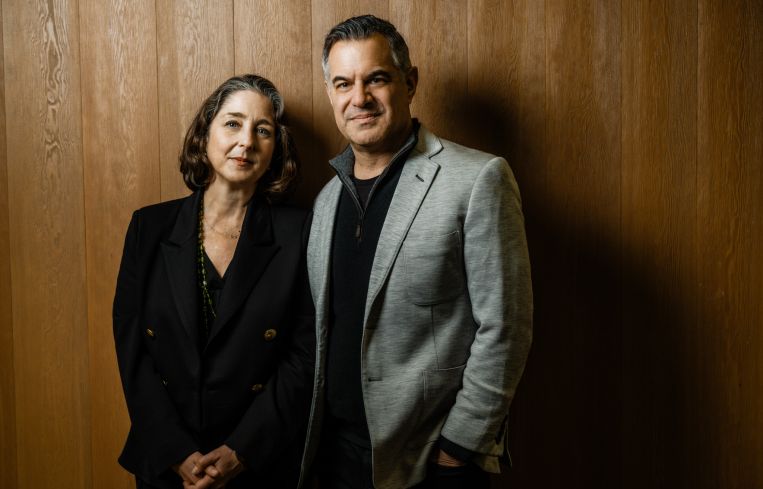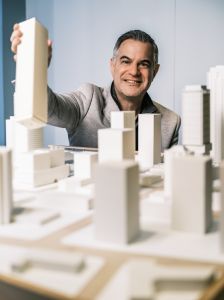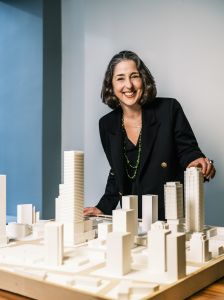Gensler Co-CEOs Elizabeth Brink and Jordan Goldstein On AI in Architecture
And on making data centers people-friendly and office conversions easier

For the last year or so, since they were named co-CEOs of Gensler, Elizabeth Brink and Jordan Goldstein have been on the run.
Not in a bad way. From their respective homes in Los Angeles (Brink) and Washington, D.C. (Goldstein), they have been tending to the various outposts of a far-flung empire that is perhaps the single most important force in architecture and design.
The two are different — but complementary — in terms of backstories and entry into the 6,300-person firm with some 57 offices around the world (with more offices expected to open in 2025).
Like a lot of real estate people, Goldstein felt an innate fascination with Legos as a kid. As a 5-year-old, he was building his own models of what he saw when his mother took him house hunting, and by high school he was drawing floor plans on the drafting table his parents gave him. By the time he was in college at the University of Maryland, he was studying architecture in Rome, and moved onto Eastern architecture in Japan by grad school. (Goldstein couldn’t figure out why people would laugh at him when he introduced himself until his sensei told him “Jordan” means “joke” in Japanese.)
As for Brink, “I was more of a dollhouse kid,” she said.
Brink didn’t think about architecture until she was well out of college (Princeton, where she majored in history and Latin American studies) and living in New York.
“I fell in love with the city. I fell in love with the space, and the place, and started getting taken to lectures, and really started to get exposed to how designers and urbanists think about space and place.” She went back to graduate school and joined the Los Angeles office of Gensler some 21 years ago. (Many members of the 500-person L.A. team slept in Gensler’s downtown offices during the fires.)
Commercial Observer sat down with Goldstein in December, and with both Brink and Goldstein in February, to discuss how one of the world’s greatest architecture firms is looking at design, conversion, AI, the Los Angeles wildfires and more in 2025.
The interviews were combined, and edited for length and clarity.
Commercial Observer: Have you been with Gensler your whole career?
Jordan Goldstein: I have. The prior CEO, Diane Hoskins, hired me straight out of grad school at the University of Pennsylvania. I had focused on digital design, and it was right in the mid-`90s when firms were starting to realize that there’s this whole 3D design, CAD [computer-aided design] world going on. Fast forward 28 years, and here’s this other point of inflection in the industry, where the rise of artificial intelligence — also pre-fabrication, robotics, all that stuff — is going to really change this profession.
So you think that things are about to change dramatically.
Goldstein: Yes, I do. The architecture, design, real estate and construction industry has never really experienced massive disruption. Buildings and the process itself hadn’t changed, really. There’s design process, bid process, build process. But with AI, it just feels like there’s a wave of disruption that’s coming into this industry. We are feeling at Gensler that rather than be reactive toward it we’re going to take a very proactive approach.
Sounds smart. What do you think are the main things that are going to change?
Goldstein: A couple of things. I think the design process itself will experience a transformation, just in the way data is used differently in design, not just in different iterations of design and exploring creativity through a much deeper realm. But it’s also how data will be utilized in artificial intelligence for predictive analytics. Like, how will a building perform? What does that mean for operations in the environment? What does it mean for looking at construction?
Being able to think through how something will get built before a shovel even hits the ground — but do it in a much more simulation-based manner, with artificial intelligence overlay. Our approach was to start writing our own software.
Do you do that in-house?
Goldstein: We do. Ten years ago, we hired a head of technology for us that was head of technology at the time for Disney Imagineering. He was in L.A., and he immediately started to build a global digital technology team that would be working with our designers.
There’s a software we wrote, we call it gBlox. Let’s say you have a site here in Midtown, and you’re thinking, “OK, maybe it’s a little bit of retail, some office, etc.” You can start plugging that in, start to create that 3D model. There’s an AI plug-in that pulls up another dialogue window. Give text prompts or image-based prompts, and you’ll get a rendering of an image, what this could look like. It will know where it is in Midtown Manhattan. It will know the zoning and code-related constraints, and it will say, “OK, well, actually, you’re too high. Here you have setbacks…”
Then, we could be sitting here — like you as client and us as designers — have this interface up, and have a co-create session where we are working together. In the older way, we go off and design for three weeks, and come back and say, “Here’s three or four options. What do you think?” “Yeah, no, it doesn’t work.” Then we go off and come back in another couple weeks. Now you’re doing this all instantaneously.
And all the designs that you already did you can’t do because the code was wrong.
Goldstein: Another one we’ve created — and this is so applicable to the real estate around New York City — is we created something called gFloors. We always put a G in front of everything. gFloors is looking at floor plates. So, Company X wants to move, and we know the kind of the design vocabulary they like to use. We can then do rapid-fire test fits of this building, that building, then run the AI-infused analytics to say, “OK, actually, these two don’t work. This one works.” Again, before it would have been a couple weeks to go off and study it.
We sat down with a large global hospitality company recently, and they said this would be amazing to start laying out and test-fitting hotels. Another one said this is actually for office-to-residential conversion.
Are you guys doing office-to-resi conversions?
Goldstein: Yeah, yeah. Actually, the first project that really kind of put us on the map here in the city was Pearl House in the Financial District. That was an office-to-resi conversion. We had another tool we created — this one was born during the pandemic — which was an algorithm that can help quickly analyze buildings whether they are ripe for conversion or not. It creates a scorecard, so, before you invested a lot of energy, time and money, this would now allow you to say that this one would work.
The big thing in office-to-residential conversion is the building core to existing window wall — i.e., the depth. Where I am in D.C., a lot of the distressed assets are too deep. In order to make those work, you would have to carve into the floors to create opportunities for natural light to come in. At Pearl House, we were able to go in and actually carve out some of the space vertically so you can run electrical and infrastructure through it — but you’re subtracting that real estate. But we added it back as additional floors at the top of the building, so we’re able to get 588 units.
Do clients come to you before they’ve bid, or is this an after-the-fact thing where they’re like, “All right, I bought this thing. Is there anything I can do with it?”
Goldstein: Definitely both. Now a lot more of the former. Especially these days when the cost of capital is so high.

Have you used AI for aesthetics? Does it have a good eye?
Goldstein: OK, so I got another G program for you. This one’s gDiffusion. This, for us, is much more of a design-oriented tool. Let’s say I did a sketch of what this space could be. In the traditional way, me or my team would build a digital model of that space, and then would apply materials and map those materials into a program, and I would hit “Render.” Those renders would be finished overnight. Then it moved to be like an hour. And now, with AI, it’s like 30 seconds.
And with the gDiffusion interface that we created, I can look at a rendering and say, “You know, the ceiling is not right.” I can bracket off that part of the image and change that and see like 10 different versions of that ceiling without having to go and remodel 10 different times. A lot of firms are very timid and hesitant around this technology. We’re leaning very hard into it.
Tell me a little bit about what’s happening in the L.A. office. You live there, right?
Elizabeth Brink: I live in L.A. It’s actually been pretty incredible to see how the leadership in the L.A. office has just immediately snapped into allowing that office to be such a safe haven for our people. It was a whole different use of the space. As people were evacuating, this was a safe haven. It’s open 24 hours a day for you and your family and pets and anything you need. And so you saw people really leaning on it as a center for our community and bringing their families in. We had families staying overnight in the conference room.
L.A. has had such a dysfunctional relation with housing and building. Are the fires one of those crisis slash opportunities for rebuilding? Do you see that at all?
Brink: Yes. I mean, L.A. — it’s an interesting place. Compared to New York it’s a dispersed environment. It’s a lot of neighborhoods that are knit together. I think absolutely in crisis there’s opportunity to say, “Hey, how could we do this better? How could we rethink things? What is it that was really special about these places that we really want to make sure we recapture? What do those places mean?” Both Altadena and Pacific Palisades had a very strong place in the emotional psychology of the city. They are neighborhoods that are very artistic, that are very connected to nature and very community oriented. So, how do you do that?
I think, in all kinds of crises — whether it’s Houston coming back after the last hurricane or New Orleans coming back after Katrina — how’s that going to be different? In L.A. we’re leaning in. We have so much creativity out there and so much goodwill. Everyone wants to bring back the city.
I’m curious whether there will be a push for more density.
Brink: It’s an evolving thing that may make sense in some parts of what needs to get rebuilt. It may not make sense in other parts of what gets rebuilt. We’ve been looking at density in housing models in Downtown L.A. What L.A. is also really looking at is density around transit nodes. So as an overlay — what is our transit situation, and how do we densify around that? Regardless of the fires, that’s been a layer of what’s happening in L.A. as well.
You guys have offices all over the world. So I almost imagine that’s perfect for a post-COVID office existence.
Goldstein: It’s totally iterative, you know. And it’s interesting because you can start a conversation by text, if you didn’t pick up by Teams or Zoom. And then, two days later, I’ll see her…
Brink: …here in New York….
Goldstein: … here in New York. You feel like it’s one stream of conversation that just continues through time, space and whatever relativity.
Brink: But there is nothing like us being in the room together to hash through things, to connect with one another to discuss the really hairy kind of issues that we need to get into. We were just in L.A., we spent a day together just sort of leaning in and talking through a lot of big issues, and then you can coast on the communication coattails of that, and leverage it out to the rest of the firm.
I imagine that all these locations are very different to work in. Which ones are the most difficult? Which one’s the easiest? Or is there no such thing as difficult or easy?
Brink: I think that every location, including those in the U.S., has its own set of market challenges. I think there are incredible opportunities. We’ve been talking a lot about incredible opportunities out in India. Right now, there’s a lot of excitement around building there and other parts of Asia. So it’s more looking at what are the right opportunities for those markets, and are there going to be challenges?
Goldstein: It’s also across multiple industries. For instance, in India I actually joined a client call very early in the morning this week because there is a client that has multiple private universities — and they’re growing like you wouldn’t believe. They’re giving us a ton of buildings, architecture and interiors; residential, academic, faculty-driven. Why? Because it’s almost like the law of averages. There’s such a population growth, there’s a need for educating the masses, but there’s only so many resources that are going into public education. There’s a huge business opportunity for private education there. So that’s fueling a real estate growth opportunity, and then that creates that ancillary development around these campuses. So, that’s interesting for us.
We’re seeing growth opportunities in Latin America for hospitality.

Did you see there was a meeting at the White House discussing $500 billion worth of investment in data centers. Is this something that’s on your radar?
Brink: Yes, data centers and critical facilities are a big, big, growing field. And I think what we’re mostly excited about is the ability to bring design and design innovation into a type of project that is not always thought of as being design-forward, and also some sustainability.
So we’re doing some work with clients that are very focused on how to create the people spaces within the data centers, sustainability, and even bringing in some mass timber type of construction into data centers, depending on where they’re built. So, yeah, the idea of bringing design into that asset class is pretty exciting for the work that we’re doing.
Goldstein: It’s actually not just in the U.S. It’s international. We’ve been looking at the data center critical facility work in England out of our Birmingham office, which is actually then also into continental Europe. Definitely in the U.S., and a lot that started off in Virginia in the Loudoun County corridor. I didn’t know this, but 70 percent of the world internet traffic goes through Loudoun County.
I did not know that either.
Goldstein: But Elizabeth said it well, that we look at it as design opportunities — not just in the facilities, but in a facility’s relationship to its surrounding areas and its communities. Because they’re often put in areas where there may have been a residential community, and this was empty land, or farmland. Right now that’s becoming data centers.
One of the next waves we are seeing is more the urban data center model. And there’s a real question that we’ve gotten now from some of our developer clients about conversion: Can office actually convert to data center? That’s an analysis we’re doing. How do you do that where you’re not having a giant box in the middle of the urban core?
Speaking of Virginia, I wanted to ask about Amazon HQ2. Tell me a little about that project.
Goldstein: I find it really interesting, because I’ve grown up in the D.C. area. That area used to be really all defense contractor-driven because of its adjacency to the Pentagon, and then when that went with all the BRAC [military] realignment way back when, you just weren’t sure what was going to happen to that community. Great residential, but the industry left it. Again, right next to D.C. National Airport right there. You have mass transit, amazing.
So, when Amazon HQ2 decided to go there, they became a new anchor and Virginia did a good job being receptive to business. Several other HQs have moved there. You have Nestle. You have Leidos. Volkswagen America is also right near there. But the HQ2 project was a great opportunity for us to work in a larger team setting about how do you really take this area and bring in all these, you know, workforces in a multi-phase scenario that plugs into the community.
Design-wise, by the way, it’s awesome. Very much the vibe of the company. I think very much on brand, but a very user-friendly workforce environment and pet-friendly.
Pet-friendly. How so?
Goldstein: There’s literally areas in there that are just for dogs.
No cats?
Brink: No one brings their cat to work.
Goldstein: If you go over there, it’s really invigorated, like the restaurant scene, which pretty much had gone away. Retail service is there again. And then the residential that popped around it — what it’s done to property values around it is, like, unbelievable. You can actually live with families around there, which is not always true of headquarters in an urban area.
I’m gonna ask you a very unfair question but: favorite child? I don’t mean your actual children — I mean favorite projects.
Brink: One I’m really excited about right now is the AltaSea project out in L.A., which is a revitalization of a Port of Los Angeles dock, and it’s turning it into a blue economy sort of incubator. And this has been going on for years. It’s one of those vision projects that takes time to get everyone aligned around and then have it moving forward. Next step is to build the education center. So, hopefully, that will be moving forward quickly. That’s one right now that is so close to my heart.
Goldstein: I would say it’s always the one that’s on the boards about to be realized. So for me, it’s the Under Armour headquarters that’s opening up next month in Baltimore. It’s the most sustainable project that we’ve done. It’s all mass timber, over 3,500 solar panels, geothermal. But it also brings together a lot of the things that we do well. It’s not just a great building architecturally. It’s a great workplace, it’s a great retail store, it’s a great health and wellness facility for athletes. It’s an awesome project.
Max Gross can be reached at mgross@commercialobserver.com.



